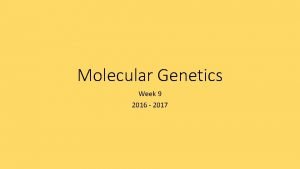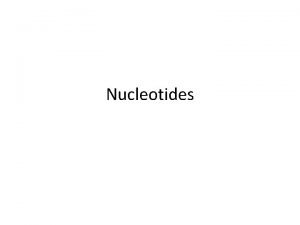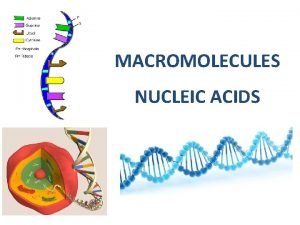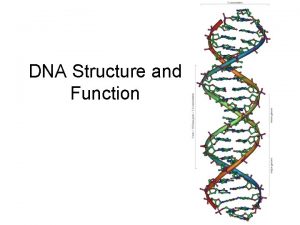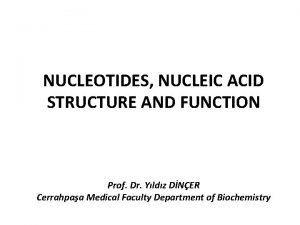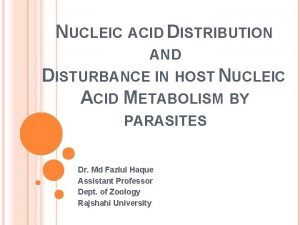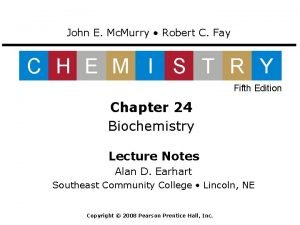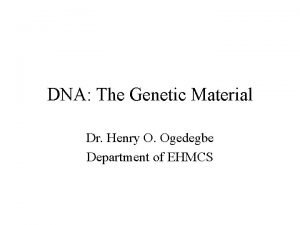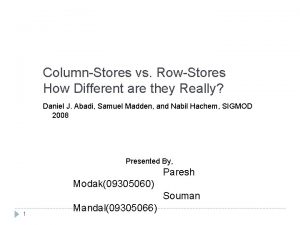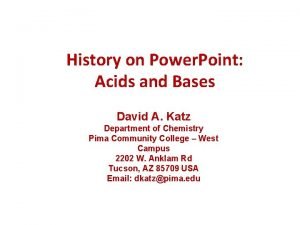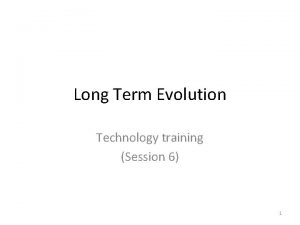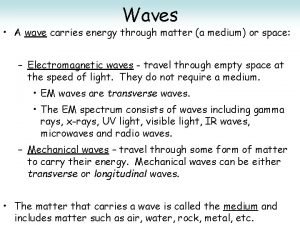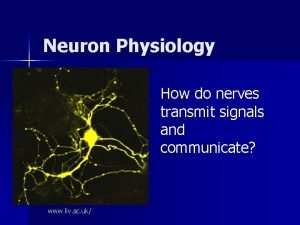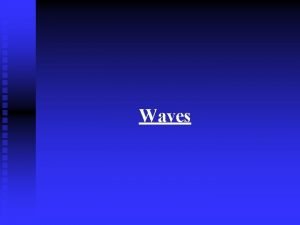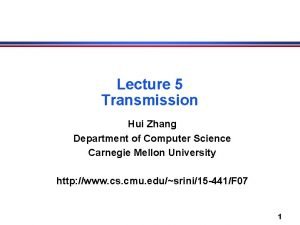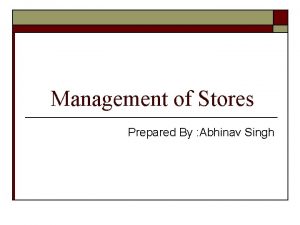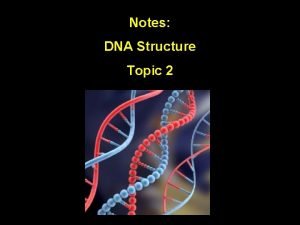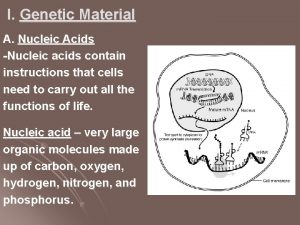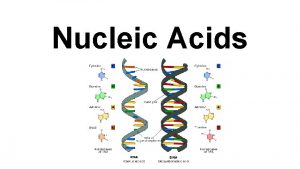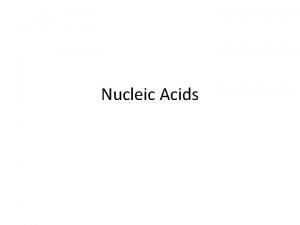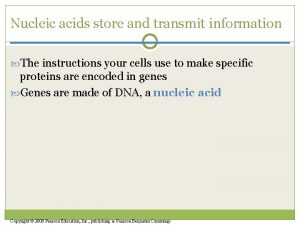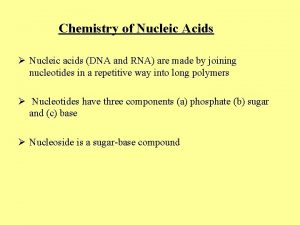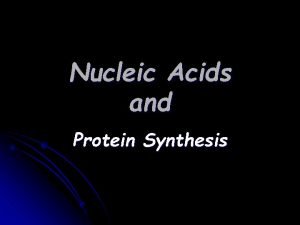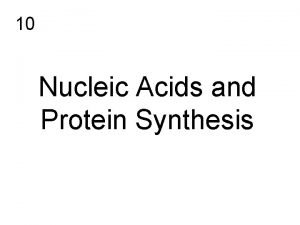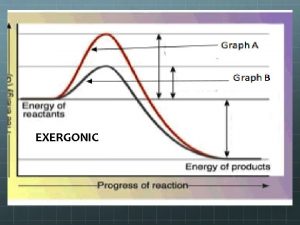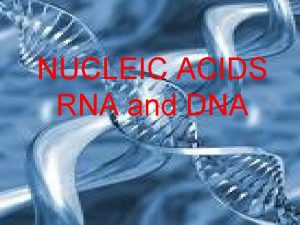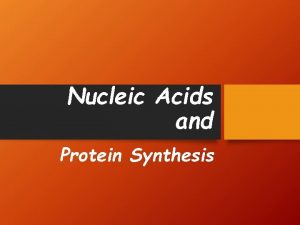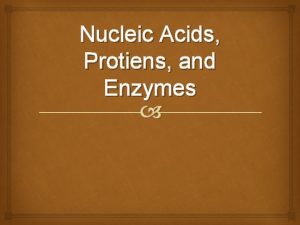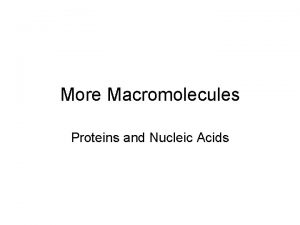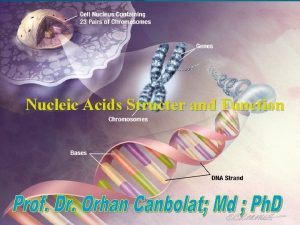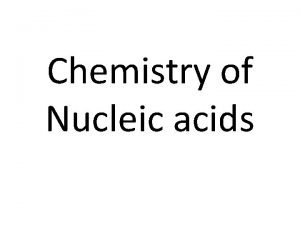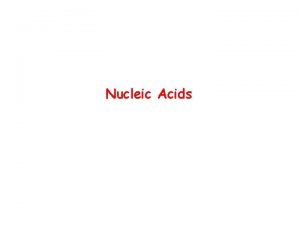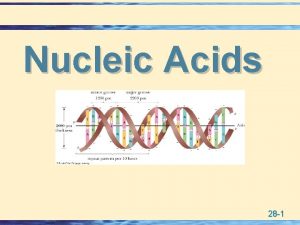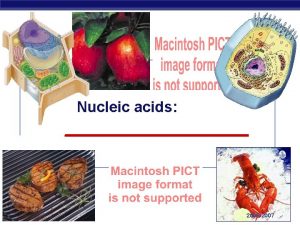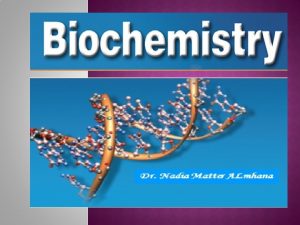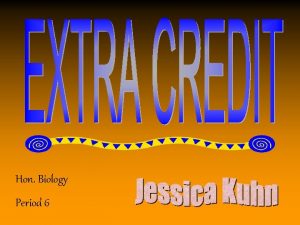Concept 5 5 Nucleic acids store and transmit





























- Slides: 29

Concept 5. 5: Nucleic acids store and transmit hereditary information • The amino acid sequence of a polypeptide is programmed by a unit of inheritance called a gene • Genes are made of DNA, a nucleic acid Copyright © 2008 Pearson Education, Inc. , publishing as Pearson Benjamin Cummings

The Roles of Nucleic Acids • There are two types of nucleic acids: – Deoxyribonucleic acid (DNA) – Ribonucleic acid (RNA) • DNA provides directions for its own replication • DNA directs synthesis of messenger RNA (m. RNA) and, through m. RNA, controls protein synthesis • Protein synthesis occurs in ribosomes Copyright © 2008 Pearson Education, Inc. , publishing as Pearson Benjamin Cummings

Fig. 5 -26 -1 DNA 1 Synthesis of m. RNA in the nucleus m. RNA NUCLEUS CYTOPLASM

Fig. 5 -26 -2 DNA 1 Synthesis of m. RNA in the nucleus m. RNA NUCLEUS CYTOPLASM m. RNA 2 Movement of m. RNA into cytoplasm via nuclear pore

Fig. 5 -26 -3 DNA 1 Synthesis of m. RNA in the nucleus m. RNA NUCLEUS CYTOPLASM m. RNA 2 Movement of m. RNA into cytoplasm via nuclear pore Ribosome 3 Synthesis of protein Polypeptide Amino acids

The Structure of Nucleic Acids • Nucleic acids are polymers called polynucleotides • Each polynucleotide is made of monomers called nucleotides • Each nucleotide consists of a nitrogenous base, a pentose sugar, and a phosphate group • The portion of a nucleotide without the phosphate group is called a nucleoside Copyright © 2008 Pearson Education, Inc. , publishing as Pearson Benjamin Cummings

Fig. 5 -27 5�end Nitrogenous bases Pyrimidines 5� C 3� C Nucleoside Nitrogenous base Cytosine (C) Thymine (T, in DNA) Uracil (U, in RNA) Purines Phosphate group 5� C (b) Nucleotide 3� C Sugar (pentose) Adenine (A) Guanine (G) Sugars 3�end (a) Polynucleotide, or nucleic acid Deoxyribose (in DNA) Ribose (in RNA) (c) Nucleoside components: sugars

Fig. 5 -27 ab 5' end 5'C 3'C Nucleoside Nitrogenous base 5'C Phosphate group 5'C 3'C (b) Nucleotide 3' end (a) Polynucleotide, or nucleic acid 3'C Sugar (pentose)

Fig. 5 -27 c-1 Nitrogenous bases Pyrimidines Cytosine (C) Thymine (T, in DNA) Uracil (U, in RNA) Purines Adenine (A) Guanine (G) (c) Nucleoside components: nitrogenous bases

Fig. 5 -27 c-2 Sugars Deoxyribose (in DNA) Ribose (in RNA) (c) Nucleoside components: sugars

Nucleotide Monomers • Nucleoside = nitrogenous base + sugar • There are two families of nitrogenous bases: – Pyrimidines (cytosine, thymine, and uracil) have a single six-membered ring – Purines (adenine and guanine) have a sixmembered ring fused to a five-membered ring • In DNA, the sugar is deoxyribose; in RNA, the sugar is ribose • Nucleotide = nucleoside + phosphate group Copyright © 2008 Pearson Education, Inc. , publishing as Pearson Benjamin Cummings

Nucleotide Polymers • Nucleotide polymers are linked together to build a polynucleotide • Adjacent nucleotides are joined by covalent bonds that form between the –OH group on the 3 carbon of one nucleotide and the phosphate on the 5 carbon on the next • These links create a backbone of sugarphosphate units with nitrogenous bases as appendages • The sequence of bases along a DNA or m. RNA polymer is unique for each gene Copyright © 2008 Pearson Education, Inc. , publishing as Pearson Benjamin Cummings

The DNA Double Helix • A DNA molecule has two polynucleotides spiraling around an imaginary axis, forming a double helix • In the DNA double helix, the two backbones run in opposite 5 → 3 directions from each other, an arrangement referred to as antiparallel • One DNA molecule includes many genes • The nitrogenous bases in DNA pair up and form hydrogen bonds: adenine (A) always with thymine (T), and guanine (G) always with cytosine (C) Copyright © 2008 Pearson Education, Inc. , publishing as Pearson Benjamin Cummings

Fig. 5 -28 5' end 3' end Sugar-phosphate backbones Base pair (joined by hydrogen bonding) Old strands Nucleotide about to be added to a new strand 3' end 5' end New strands 5' end 3' end

DNA and Proteins as Tape Measures of Evolution • The linear sequences of nucleotides in DNA molecules are passed from parents to offspring • Two closely related species are more similar in DNA than are more distantly related species • Molecular biology can be used to assess evolutionary kinship Copyright © 2008 Pearson Education, Inc. , publishing as Pearson Benjamin Cummings

The Theme of Emergent Properties in the Chemistry of Life: A Review • Higher levels of organization result in the emergence of new properties • Organization is the key to the chemistry of life Copyright © 2008 Pearson Education, Inc. , publishing as Pearson Benjamin Cummings

Fig. 5 -UN 2

Fig. 5 -UN 2 a

Fig. 5 -UN 2 b

% of glycosidic linkages broken Fig. 5 -UN 3 100 50 0 Time

Fig. 5 -UN 4

Fig. 5 -UN 5

Fig. 5 -UN 6

Fig. 5 -UN 7

Fig. 5 -UN 8

Fig. 5 -UN 9

Fig. 5 -UN 10

You should now be able to: 1. List and describe the four major classes of molecules 2. Describe the formation of a glycosidic linkage and distinguish between monosaccharides, disaccharides, and polysaccharides 3. Distinguish between saturated and unsaturated fats and between cis and trans fat molecules 4. Describe the four levels of protein structure Copyright © 2008 Pearson Education, Inc. , publishing as Pearson Benjamin Cummings

You should now be able to: 5. Distinguish between the following pairs: pyrimidine and purine, nucleotide and nucleoside, ribose and deoxyribose, the 5 end and 3 end of a nucleotide Copyright © 2008 Pearson Education, Inc. , publishing as Pearson Benjamin Cummings
 What is an anticodon
What is an anticodon Stores and transmits genetic (hereditary) information
Stores and transmits genetic (hereditary) information Biomedical importance of nucleotides
Biomedical importance of nucleotides Composition of nucleic acids
Composition of nucleic acids The building block of nucleic acid
The building block of nucleic acid Dna polymer and monomer
Dna polymer and monomer Importance of nucleic acid
Importance of nucleic acid Cytosio
Cytosio Nucleic acids
Nucleic acids Nucleotides function
Nucleotides function Function of nucleic acids
Function of nucleic acids Nucleic acid food examples
Nucleic acid food examples Nucleic acids
Nucleic acids Nature of nucleic acid
Nature of nucleic acid Row store vs column store
Row store vs column store Row store vs column store
Row store vs column store Explain bronsted lowry concept of acids and bases
Explain bronsted lowry concept of acids and bases Punished by his love chapter 1201
Punished by his love chapter 1201 Transmit diversity in lte
Transmit diversity in lte What waves do not require a medium
What waves do not require a medium Neuron physiology
Neuron physiology Forme de dialog
Forme de dialog Automatic transmit power control
Automatic transmit power control Transmit waves
Transmit waves Mechanical and electromagnetic waves venn diagram
Mechanical and electromagnetic waves venn diagram Transmit light
Transmit light Hui transmit data
Hui transmit data Management of stores
Management of stores Labeled dna structure diagram
Labeled dna structure diagram Genetic material
Genetic material
